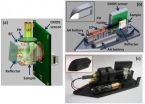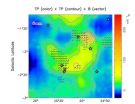(Press-News.org) CAMBRIDGE, Mass. -- New research from MIT suggests that there are parts of our brain dedicated to language and only language, a finding that marks a major advance in the search for brain regions specialized for sophisticated mental functions.
Functional specificity, as it's known to cognitive scientists, refers to the idea that discrete parts of the brain handle distinct tasks. Scientists have long known that functional specificity exists in certain domains: In the motor system, for example, there is one patch of neurons that controls the fingers of your left hand, and another that controls your tongue. But what about more complex functions such as recognizing faces, using language or doing math? Are there special brain regions for those activities, or do they use general-purpose areas that serve whatever task is at hand?
Language, a cognitive skill that is both unique to humans and universal to all human cultures, "seems like one of the first places one would look" for this kind of specificity, says Evelina Fedorenko, a research scientist in MIT's Department of Brain and Cognitive Sciences and first author of the new study. But data from neuroimaging — especially functional magnetic resonance imaging (fMRI), which measures brain activity associated with cognitive tasks — has been frustratingly inconclusive. Though studies have largely converged on several areas important for language, it's been hard to say whether those areas are exclusive to language. Many experiments have found that non-language tasks seemingly activate the same areas: Arithmetic, working memory and music are some of the most common culprits.
But according to Fedorenko and her co-authors — Nancy Kanwisher, the Walter A. Rosenblith Professor of Cognitive Neuroscience, and undergraduate student Michael Behr — this apparent overlap may simply be due to flaws in methodology, i.e., how fMRI data is traditionally gathered and analyzed. In their new study, published in this week's Proceedings of the National Academy of Sciences, they used an innovative technique they've been developing over the past few years; the new method yielded evidence that there are, in fact, bits of the brain that do language and nothing else.
Forget the forest, it's all in the trees
fMRI studies of language are typically done by group analysis, meaning that researchers test 10, 20 or even 50 subjects, then average data together onto a common brain space to search for regions that are active across brains.
But Fedorenko says this is not an ideal way to do things, mainly because the fine-grained anatomical differences between brains can cause data "smearing," making it look as if one region is active in two different tasks when in reality, the tasks activate two neighboring — but not overlapping — regions in each individual subject.
By way of analogy, she says, imagine taking pictures of 10 people's faces and overlaying them, one on top of another, to achieve some sort of average face. While the resulting image would certainly look like a face, when you compared it back to the original pictures, it would not line up perfectly with any of them. That's because there is natural variation in our features — the size of our foreheads, the width of our noses, the distance between our eyes.
It's the same way for brains. "Brains are different in their folding patterns, and where exactly the different functional areas fall relative to these patterns," Fedorenko says. "The general layout is similar, but there isn't fine-grained matching." So, she says, analyzing data by "aligning brains in some common space … is just never going to be quite right."
Ideally, then, data would be analyzed for each subject individually; that is, patterns of activity in one brain would only ever be compared to patterns of activity from that same brain. To do this, the researchers spend the first 10 to 15 minutes of each fMRI scan having their subject do a fairly sophisticated language task while tracking brain activity. This way, they establish where the language areas lie in that individual subject, so that later, when the subject performs other cognitive tasks, they can compare those activation patterns to the ones elicited by language.
A linguistic game of 'Where's Waldo?'
This methodology is exactly what allows Fedorenko, Behr and Kanwisher to see if there are areas truly specific to language. After having their subjects perform the initial language task, which they call a "functional localizer," they had each one do a subset of seven other experiments: one on exact arithmetic, two on working memory, three on cognitive control and one on music, since these are the functions "most commonly argued to share neural machinery with language," Fedorenko says.
Out of the nine regions they analyzed — four in the left frontal lobe, including the region known as Broca's area, and five further back in the left hemisphere — eight uniquely supported language, showing no significant activation for any of the seven other tasks. These findings indicate a "striking degree of functional specificity for language," as the researchers report in their paper.
Future studies will test the newly identified language areas with even more non-language tasks to see if their functional specificity holds up; the researchers also plan to delve deeper into these areas to discover which particular linguistic jobs each is responsible for.
Fedorenko says the results don't imply that every cognitive function has its own dedicated piece of cortex; after all, we're able to learn new skills, so there must be some parts of the brain that are both high-level and functionally flexible. Still, she says, the results give hope to researchers looking to draw some distinctions within in the human cortex: "Brain regions that do related things may be nearby … [but] it's not just all one big mushy multifunctional thing in there."
###http://web.mit.edu/press/
Localizing language in the brain
New study pinpoints areas of the brain used exclusively for language, providing a partial answer to a longstanding debate in cognitive science
2011-08-31
ELSE PRESS RELEASES FROM THIS DATE:
Role of soy in menopausal health reported
2011-08-31
Soy has recently been reviewed and supported for introduction into general medical practice as a treatment for distressing vasomotor symptoms of menopause, such as hot flashes, but its use in other medical areas, such as heart health, requires further research, according to a new report reviewing the risks and benefits of soy protein, isoflavones and metabolites in menopausal health from The North American Menopause Society (NAMS)/Wulf H. Utian Translational Science Symposium, published in the July Menopause, the peer-reviewed NAMS journal.
"Although a significant amount ...
Microscope on the go: Cheap, portable, dual-mode microscope uses holograms, not lenses
2011-08-31
WASHINGTON, Aug. 30—To serve remote areas of the world, doctors, nurses and field workers need equipment that is portable, versatile, and relatively inexpensive. Now researchers at the University of California at Los Angeles (UCLA) have built a compact, light-weight, dual-mode microscope that uses holograms instead of lenses. The team describes the new device in a paper published today in the Optical Society's (OSA) open-access journal Biomedical Optics Express.
Their prototype weighs about as much as a medium-sized banana and fits in the palm of a hand. And, since it ...
IU analysis changing diagnosis and management of initial UTIs in young children
2011-08-31
INDIANAPOLIS – Analysis by Indiana University School of Medicine researchers of ten years of scientific studies has resulted in changes in American Academy of Pediatrics recommendations for how initial urinary tract infection in infants and toddlers is diagnosed and treated. This change will affect thousands of children every year.
The findings of the IU School of Medicine investigators argue against exposing all young children who are diagnosed with an initial urinary tract infection (UTI) to a painful radiologic test and against prescribing prophylactic antibiotic treatment ...
The Great Recession could reduce school achievement for children of unemployed
2011-08-31
The Great Recession could have lingering impacts on the children of the unemployed, according to researchers at the University of Chicago.
"There is growing evidence that parental job loss has adverse consequences on children's behavior, academic achievement and later employment outcomes, particularly in economically disadvantaged families," said Heather Hill, assistant professor in the University of Chicago School of Social Service Administration. The material hardship and stress associated with unemployment appears to reduce the quality of the home environment and ...
Future climate change may increase asthma attacks in children
2011-08-31
Mount Sinai School of Medicine researchers have found that climate change may lead to more asthma-related health problems in children, and more emergency room (ER) visits in the next decade.
The data, published in the current issue of the American Journal of Preventive Medicine, found that changing levels of ozone could lead to a 7.3 percent increase in asthma-related emergency room visits by children, ages 0-17.
The research team, led by Perry Sheffield, MD, Assistant Professor of Preventive Medicine at Mount Sinai School of Medicine, used regional and atmospheric ...
Beyond pills: Cardiologists examine alternatives to halt high blood pressure
2011-08-31
More and more, patients show up to appointments with hypertension expert John Bisognano, M.D., Ph.D. carrying bags full of "natural" products that they hope will help lower their blood pressure. And like most physicians, Bisognano doesn't always know if these products will do any good, or if they will cause any harm.
"Right now we're seeing a cultural shift where an increasing number of people want to avoid standard pharmaceuticals," said Bisognano, professor of Medicine and director of Outpatient Cardiology at the University of Rochester Medical Center. "We're also ...
More questions than answers remain concerning effects of airplane travel on insulin pump delivery
2011-08-31
New Rochelle, NY, August 30, 2011—Despite recent concerns that changes in atmospheric pressure during airplane travel may affect the amount of insulin delivered via pump devices, the current evidence is limited and it would be unwise to overreact until more data are available, according to an insightful editorial in Diabetes Technology & Therapeutics, a peer-reviewed journal published by Mary Ann Liebert, Inc. The editorial is available free online.
Irl B. Hirsch, MD, Professor of Medicine, University of Washington School of Medicine (Seattle), and Senior Editor of Diabetes ...
An atlas of the Milky Way
2011-08-31
This press release is available in German.
It may not be much use to hitchhikers through the galaxy, but it is extremely valuable to astronomers: the new radio atlas of the Milky Way. After almost ten years of work, researchers at the Max Planck Society and the Chinese Academy of Sciences have completed their investigation into the polarised radio emission in the galactic plane. The atlas is based on observations undertaken with the 25-metre radio telescope in the Chinese city of Urumqi and shows an area of 2,200 square degrees of the sky.
The radio survey covers ...
FoundUB4 Offers Facebook Advertising Consultancy To Businesses Of All Sizes
2011-08-31
Facebook marketing is an essential component of any complex social media marketing promotion campaign. An increasing number of business owners realize this, but they do not have the relevant knowledge or skills to set up an attractive business page or group that will attract customers.
There is a huge amount of money to be made on the site, and that is why many of them are asking for help from a professional Facebook advertising consultant.
If you have heard success stories about Facebook already, you will know that it is worth the try. Still, you will need to face ...
The diamond planet
2011-08-31
A star that changes into a diamond planet? What sounds like science fiction is apparently reality. The discovery was made by an international team of scientists from Australia, Italy, Great Britain, the USA and Germany, including Michael Kramer from the Max Planck Institute for Radio Astronomy in Bonn. The researchers found the diamond planet with the help of the 64-metre Parkes radio telescope in Australia. The planet apparently orbits around an unusual, very dense star, a pulsar.
Pulsars represent the very last stages of star formation. They are rapidly rotating neutron ...
LAST 30 PRESS RELEASES:
For teens, any cannabis use may have impact on emotional health, academic performance
School meals could unlock major gains for human and planetary health
Menopause hormone therapy does not appear to impact dementia risk
Signature patterns of brain activity may help predict recovery from traumatic brain injury
Dresden study uncovers new key mechanism in cancer cells
New species are now being discovered faster than ever before, study suggests
Cannabis-based products show limited short-term benefit for chronic pain, with increased risk of adverse effects
Cannabis products with more THC slightly reduce pain but cause more side effects
Clearing the brain of aging cells could aid epilepsy and reduce seizures
Brain injuries linked with potential risk of suicide, new study finds
New technique lights up where drugs go in the body, cell by cell
New study finds movement of fishing fleets can reveal shifts in marine ecosystems
Embargoed: New evidence points to potential treatment for vascular dementia
Study uncovers disrupted brain balance in alcohol dependence
Working in groups can help Republicans and Democrats agree on controversial content moderation online
Structural findings reveal how distinct GPCR ligands create different levels of activation
Anything-goes “anyons” may be at the root of surprising quantum experiments
UC review: Maximizing workplace opportunity for veterans
From generation to complex control: Metasurfaces make perfect vortex beams "within reach"
Thin-film lithium niobate-based detector: recent advances and perspectives
Exploring why some people may tend to persistently make bad choices
How cells balance their protein levels
Nirsevimab vs RSVpreF vaccine for RSV–related hospitalization in newborns
Effectiveness and impact of maternal RSV immunization and nirsevimab on medically attended RSV in US children
AI gives scientists a boost, but at the cost of too many mediocre papers
Next-generation vision model maps tree growth at sub-meter precision
Genes aren’t destiny for inherited blindness, study shows
MIT study: High-fat diets make liver cells more likely to become cancerous
Exposure to multiple fine particulate matter components and incident depression in the US Medicare population
Risk of burdensome health care spending over time in the US
[Press-News.org] Localizing language in the brainNew study pinpoints areas of the brain used exclusively for language, providing a partial answer to a longstanding debate in cognitive science




